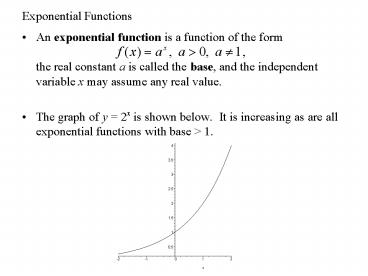Exponential Functions - PowerPoint PPT Presentation
1 / 13
Title:
Exponential Functions
Description:
The graph of has the horizontal asymptote y = 0. ... Horizontal asymptote of an exponential function. Solving exponential equations. The number e ... – PowerPoint PPT presentation
Number of Views:35
Avg rating:3.0/5.0
Title: Exponential Functions
1
Exponential Functions
- An exponential function is a function of the form
the real constant
a is called the base, and the independent
variable x may assume any real value. - The graph of y 2x is shown below. It is
increasing as are all exponential functions with
base gt 1.
2
More about Exponential Functions
- The graph of y is shown next. It is
decreasing as are all exponential functions with
0 lt base lt 1. - Since exponential functions are increasing or
decreasing, it follows that they are one-to-one.
Why? - By examining the graph we conclude that the range
of an exponential function is the set of positive
real numbers.
3
More about Exponential Functions
- The graph of always passes
through the points (0, 1) and (1, a). - The graph of is the reflection
about the y-axis of the graph of - The graph of has the horizontal
asymptote y 0. - If there are two exponential functions
and a lt b, then
4
Solving Exponential Equations
- If ?
? - Example. Solve 310 35x. By the previous
bullet points, - Example. Solve. 27 (x1)7. By the previous
bullet points,
5
The Number e
- As the real number m gets larger and larger,
- The limiting value 2.71828... is an irrational
number known as e. - In order to simplify certain formulas,
exponential functions are often written with base
e. - For x gt 0, 2x lt ex lt 3x.
6
Compound Interest
- When the money in an account receives compound
interest, each interest payment includes interest
on the previously accrued interest. - Example. 100 compounded annually at 10
interest for 3 years, and P dollars compounded
annually at r interest for 3 years
Year Starting Amount Ending Amount StartingAmount Ending Amount
1 100 100(10.1) 110 P P(1r)
2 110 110(10.1) 121 P(1r) P(1r)2
3 121 121(10.1) 133.10 P(1r)2 P(1r)3
7
Compound Interest Formula
- If the interest on an account at r annually is
compounded k times per year, the interest rate
applied to each accounting period is r/k. - When k 2, we say that interest is compounded
semiannually, when k 4, we say that interest is
compounded quarterly, and when k 12, we say
that interest is compounded monthly. - In general, if P dollars are invested at an
annual interest rate r (expressed in decimal
form) compounded k times annually, then the
amount A available at the end of t years is
8
Compound Interest Example
- Suppose that 6000 is invested at an annual rate
of 8. What will be the value of the investment
after 3 years if (a) interest is compounded
quarterly?
(b) interest is compounded
semiannually? - In which case, (a) or (b), is the total amount of
interest greater? Why?
9
Continuous Compounding
- Suppose we let the number of compounding periods
k increase without bound. (imagine compounding
every second, then every millisecond, etc.). The
amount of the investment of P dollars after t
years approaches a limit - When the above situation pertains, we say that we
are compounding continuously. - In general, if P dollars are invested at an
annual interest rate r (expressed in decimal
form) compounded continuously, then the amount A
available at the end of t years is
10
Compound Interest Examples
- Example. Suppose that 6000 is invested at an
annual rate of 8. What will be the value of the
investment after 3 years if interest is
compounded continuously? - Note that the amount of the investment after 3
years is greater than it was when compounding was
done semiannually or quarterly? Why? - Example. Suppose that a principal P is to be
invested at continuous compound interest of 8
per year to yield 10,000 in 5 years. How much
should be invested?
11
Exponential Growth Model--World Population
- A model which predicts the quantity Q, which is
number or biomass, for a population at time t is
the following exponential growth
model
Both q0 and k are constants specific to the
particular population in question, and k is
called the growth constant. - For the world population, k 0.019 and q0 6
billion when t 0 corresponds to the year
2000. The model is
In the year 2010, the model predicts a world
population of
12
Exponential Decay Model
- A model which predicts the quantity Q, which is
mass, for a particular radioactive element at
time t is the following exponential decay
model Both
q0 and k are constants specific to the particular
radioactive sample in question, and k is called
the decay constant. We use the term half-life to
describe the time it takes for half of the atoms
of a radioactive element to break down. - A radioactive substance has a decay rate of 5
per hour. If 500 grams are present initially,
how much remains after 4 hours?
13
Summary of Exponential Functions We discussed
- Definition of an exponential function and its
base - Fact that exponential functions are increasing or
decreasing and therefore they are one-to-one - Range of an exponential function
- Horizontal asymptote of an exponential function
- Solving exponential equations
- The number e
- The formula for compound interest
- The formula for continuous compounding
- Exponential growth and decay































